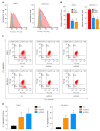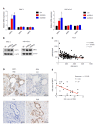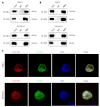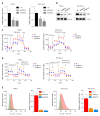Zinc finger E-box-binding homeobox 1 mediates aerobic glycolysis via suppression of sirtuin 3 in pancreatic cancer
- PMID: 30487699
- PMCID: PMC6250915
- DOI: 10.3748/wjg.v24.i43.4893
Zinc finger E-box-binding homeobox 1 mediates aerobic glycolysis via suppression of sirtuin 3 in pancreatic cancer
Abstract
Aim: To uncover the roles of tumor-promoting gene ZEB1 in aerobic glycolysis regulation and shed light on the underlying molecular mechanism.
Methods: Endogenous zinc finger E-box binding homeobox-1 (ZEB1) was silenced using a lentivirus-mediated method, and the impact of ZEB1 and methyl-CpG binding domain protein 1 (MBD1) on aerobic glycolysis was measured using seahorse cellular flux analyzers, reactive oxygen species quantification, and mitochondrial membrane potential measurement. The interaction between ZEB1 and MBD1 was assessed by co-immunoprecipitation and immunofluorescence assays. The impact of ZEB1 and MBD1 interaction on sirtuin 3 (SIRT3) expression was confirmed by quantitative polymerase chain reaction, western blotting, and dual-luciferase and chromatin-immunoprecipitation assays.
Results: ZEB1 was a positive regulator of aerobic glycolysis in pancreatic cancer. ZEB1 transcriptionally silenced expression of SIRT3, a mitochondrial-localized tumor suppressor, through interaction with MBD1.
Conclusion: ZEB1 silenced SIRT3 expression via interaction with MBD1 to promote aerobic glycolysis in pancreatic cancer.
Keywords: Glycolysis; Methyl-CpG binding domain protein 1; Pancreatic cancer; Sirtuin 3; Zinc finger E-box binding homeobox-1.
Conflict of interest statement
Conflict-of-interest statement: The authors have declared no conflicts of interest.
Figures







Similar articles
-
Zinc-Dependent Regulation of ZEB1 and YAP1 Coactivation Promotes Epithelial-Mesenchymal Transition Plasticity and Metastasis in Pancreatic Cancer.Gastroenterology. 2021 Apr;160(5):1771-1783.e1. doi: 10.1053/j.gastro.2020.12.077. Epub 2021 Jan 6. Gastroenterology. 2021. PMID: 33421513 Free PMC article.
-
miR-128 modulates chemosensitivity and invasion of prostate cancer cells through targeting ZEB1.Jpn J Clin Oncol. 2015 May;45(5):474-82. doi: 10.1093/jjco/hyv027. Epub 2015 Mar 25. Jpn J Clin Oncol. 2015. PMID: 25921099
-
ERK2-mediated phosphorylation of ZEB1 at S322 enhances PD-L1 expression and EMT, leading to pancreatic cancer progression.Cell Commun Signal. 2025 Apr 28;23(1):204. doi: 10.1186/s12964-025-02182-3. Cell Commun Signal. 2025. PMID: 40296122 Free PMC article.
-
Unleashing the pathological imprinting of cancer in autoimmunity: Is ZEB1 the answer?Life Sci. 2023 Nov 1;332:122115. doi: 10.1016/j.lfs.2023.122115. Epub 2023 Sep 20. Life Sci. 2023. PMID: 37739160 Review.
-
Glycometabolic rearrangements--aerobic glycolysis in pancreatic cancer: causes, characteristics and clinical applications.J Exp Clin Cancer Res. 2020 Nov 30;39(1):267. doi: 10.1186/s13046-020-01765-x. J Exp Clin Cancer Res. 2020. PMID: 33256814 Free PMC article. Review.
Cited by
-
Mitochondrial sirtuins: Energy dynamics and cancer metabolism.Mol Cells. 2024 Feb;47(2):100029. doi: 10.1016/j.mocell.2024.100029. Epub 2024 Feb 6. Mol Cells. 2024. PMID: 38331199 Free PMC article. Review.
-
lncRNA CYTOR promotes aberrant glycolysis and mitochondrial respiration via HNRNPC-mediated ZEB1 stabilization in oral squamous cell carcinoma.Cell Death Dis. 2022 Aug 13;13(8):703. doi: 10.1038/s41419-022-05157-1. Cell Death Dis. 2022. PMID: 35963855 Free PMC article.
-
Cancer-associated fibroblast-secreted miR-421 promotes pancreatic cancer by regulating the SIRT3/H3K9Ac/HIF-1α axis.Kaohsiung J Med Sci. 2022 Nov;38(11):1080-1092. doi: 10.1002/kjm2.12590. Epub 2022 Oct 6. Kaohsiung J Med Sci. 2022. PMID: 36200682 Free PMC article.
-
Colorectal Cancer Stem Cells in the Progression to Liver Metastasis.Front Oncol. 2020 Aug 20;10:1511. doi: 10.3389/fonc.2020.01511. eCollection 2020. Front Oncol. 2020. PMID: 32974184 Free PMC article. Review.
-
Sirtuins as Key Regulators in Pancreatic Cancer: Insights into Signaling Mechanisms and Therapeutic Implications.Cancers (Basel). 2024 Dec 6;16(23):4095. doi: 10.3390/cancers16234095. Cancers (Basel). 2024. PMID: 39682281 Free PMC article. Review.
References
-
- Mittal V. Epithelial Mesenchymal Transition in Tumor Metastasis. Annu Rev Pathol. 2018;13:395–412. - PubMed
-
- Jiang JH, Liu C, Cheng H, Lu Y, Qin Y, Xu YF, Xu J, Long J, Liu L, Ni QX, et al. Epithelial-mesenchymal transition in pancreatic cancer: Is it a clinically significant factor? Biochim Biophys Acta. 2015;1855:43–49. - PubMed
-
- Krebs AM, Mitschke J, Lasierra Losada M, Schmalhofer O, Boerries M, Busch H, Boettcher M, Mougiakakos D, Reichardt W, Bronsert P, et al. The EMT-activator Zeb1 is a key factor for cell plasticity and promotes metastasis in pancreatic cancer. Nat Cell Biol. 2017;19:518–529. - PubMed
MeSH terms
Substances
LinkOut - more resources
Full Text Sources
Medical
Molecular Biology Databases
Research Materials

